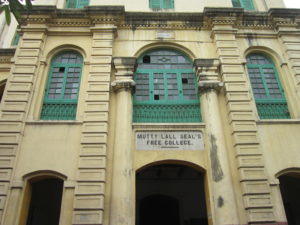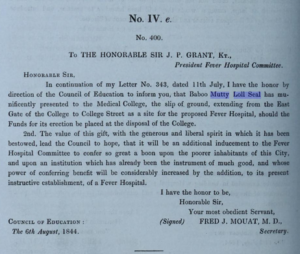Notable Events in Mutty Lall Seal’s Life
As he grew famous in the mercantile world, Mutty Lall Seal also engaged in many schemes to improve human welfare. He is said to have donated a sum of 12000 for the construction of Medical College on 1st June 1831. Besides this, he also granted a large tract of land for the construction of the Calcutta Fever Hospital. The contemporary government authorities expressed their appreciation of his benevolent efforts by naming a ward in his honor, ‘The Mutty Lall Seal Ward’, for Indian male patients. Alongside this, another act of his open-minded liberal approach was the donation of a lakh of rupees for the establishment of a female (lying in) hospital for pregnant women, which started functioning in 1838. In 1836, a bolt of lightning is said to have narrowly missed Seal when it struck his house in Colootollah. The lightning managed to damage the frame of his portrait (see here).

Mutty Lall Seal’s Free College. Founded 1842
On 29th February 1840, Seal contributed one lakh rupees to sponsor better education for the students of Medical College, as had been published in the Literary Gazette (Laha 1940:15). In 1841, he fulfilled his long-cherished dream of establishing an Almshouse and Thakurbari at Belghoria. The thakurbari is said to have fed around five hundred to thousand people daily. Later, during the devastating famine in 1846, his son Heeralal, followed in his father’s footsteps by supplying food and clothing to the victims. Mutty Lall Seal also commissioned the construction of an imposing ghat on the bank of Hooghly River known as ‘Mutty Lall Seal Ghat’. It is situated next to the Armenian Launch Ghat. He also donated money towards the establishment of the District Charitable Trust which also included a Leprosy Hospital (Bandyopadhyay 1933). Seal also collaborated with Madhub Dutt in building an aqueduct connecting Colootollah Street to Chitpore Road so that the local residents could get a steady supply of clean water in the neighbourhood tank (Asiatic Intelligence 1838). He is also credited with building a hospital for lepers on Mirzapore Street. Always the progressive, Seal is recorded as one of the early supporters of inoculation against smallpox (see link). He also made his tank in his garden-house at Garden Reach available for experiments on telegraphy. Lord Dalhousie was present on the occasion and Dr W.B. O’ Shaughnessy’s experiment was a success (see here). His support for the introduction of railways in India is also well-known.
After his famous speech criticizing the lack of generosity among the Dharma Sabha members, Seal announced a Widows and Orphans Fund for Hindu families, where he provided a pension of 500 to 700 rupees per month. This money was distributed by the Mutty Lall Seal’s Trust Fund (Laha 1940:19). Seal is also recorded to have paid the indenture-money to release youths who had been abducted and sold as coolies (See letter by William Dowson).
In the early nineteenth century, the Hindu community was alarmed by the tactics used by the Christian missionary schools to proselytize. To counter this, the baboos of Calcutta fostering anti-missionary sentiments began to push for the introduction of free national schools for their fellow countrymen. Firmly believing in this idea, Mutty Lall Seal founded and endowed the Seal’s Free College in 1842. The formal inauguration of the College took place at Seal’s Colootollah residence. Though he himself did not receive liberal education, yet he uphold the view that it was absolutely essential for the progress of his countrymen. In 1843, after having been convinced that the Jesuits were the most efficient teachers, the school was placed under the management of St. Xavier’s College. In 1844, due to a dispute over an administrative issue, Seal eventually broke off all his ties with the Jesuits. The college’s administration was handed over to Captain Francis Palmer and a group of Indian teachers (Laha 1940:15).

